Articles
“The school book question is a farce”:
Free Textbook Provision in Nova Scotia, 1864-1944
Nova Scotia’s delayed introduction of a free school textbook policy until 1935 occurred without public debate – despite objections from booksellers and parental concerns about the spread of contagious diseases – and was due to three reasons: the strong opposition of Superintendent of Education Henry F. Munro, the state of the province’s economy, and the absence of advocacy on the part of lobby groups or members of the public. In the end, it was Liberal Premier Angus L. Macdonald, who, in spite of challenges, acted on a campaign promise to make textbooks free for all students in grades 1 to 8.
L’introduction d’une politique de gratuité des manuels scolaires en Nouvelle-Écosse, retardée jusqu’en 1935, eut lieu sans débat public – malgré les objections des libraires et les craintes de parents concernant la propagation de maladies contagieuses. Elle fut retardée pour trois raisons : la forte opposition du surintendant des écoles Henry F. Munro, l’état de l’économie provinciale et l’absence d’initiatives de promotion en ce sens de la part de groupes de pression ou du public. En fin de compte, c’est le premier ministre libéral, Angus L. Macdonald, qui, en dépit de difficultés, tint la promesse électorale de rendre les manuels scolaires gratuits pour tous les élèves de la 1re à la 8e année.
1 WHEN BOOKSELLER I.G. MACLEAN OF PICTOU, NOVA SCOTIA, commented in 1922 that “the school book question is a farce,” he was alluding to several issues relating to the provision of textbooks in the province. His chief complaint was the need to provide credit to parents who could not afford a large outlay for books each September: “If people have not the money they should not have the books.”1 He did not clarify how children in such families were to get their education. MacLean may or may not have been expressing the prevailing view of educators, the public at large, or even of other booksellers, but it is interesting to see this view expressed at a time when several other provinces had been supplying textbooks free of charge under various arrangements for some time. Nova Scotia itself, little more than ten years later, would be providing free textbooks for all elementary students.
2 Nova Scotia implemented a free textbook policy for all students in grades 1 through 8 in 1935. As will be seen, when compared to other provinces this was neither particularly early nor particularly late. It would likely have been earlier if not for the strong opposition of Superintendent of Education Henry F. Munro, coupled with challenging economic circumstances and the absence of powerful interest groups prepared to lobby on behalf of students and parents. In the end, it was a politician rather than an educator who made textbooks free of charge. In spite of enormous challenges, Liberal Premier Angus L. Macdonald instituted a free textbook policy in the midst of the Great Depression. This study examines the establishment of a free textbook policy in Nova Scotia in the comparative context of other provinces and British Columbia in particular, because that province had the earliest comprehensive policy on free textbooks in the country.
3 Although the provision of free textbooks was an important step in providing equal access to education, this has not been acknowledged in the scholarly literature. Many Canadian studies have analyzed textbook content,2 and there has been limited work on textbook publishing,3 but few studies have examined textbook distribution. The studies that have examined distribution have looked at the role of the booksellers in distributing textbooks through sales to parents and at mail-order sales by the T. Eaton’s Company.4 The only work that centres on free textbook distribution is a 2009 study on the establishment of the Free Text-Book Branch in British Columbia.5 The present study seeks to address this lacuna in the scholarly record by providing a close examination of the establishment of a free textbook system in the province of Nova Scotia set within a comparative context of other provinces.
4 A five-stage model for the study of book culture by Thomas R. Adams and Nicolas Barker offers a useful way to frame the process by which textbooks are produced and eventually made available to their student users. The stages in this model are publishing, manufacturing, distribution, reception, and survival. This model, unlike others, privileges publishing over authorship to the point of omitting an authorship stage altogether. The elevation of publishing over authorship is particularly applicable to textbook production because the textbook publisher takes a more prominent and diverse role than is assumed in the production of trade books. In the case of textbooks, the publisher typically seeks out authors who are curriculum developers or who have had other types of educational leadership roles rather than receiving unsolicited manuscripts. Furthermore, the textbook publisher maintains control over content, often providing the author with provincial curriculum guidelines, content outlines, and/or scope and sequence charts to follow. The author’s voice is therefore limited in the final product. The publisher is also more involved post-production, taking an active role in lobbying provincial governments for authorization status for its textbooks.
5 The textbook publisher is also more active than a trade book publisher at the distribution stage. This stage involves the means employed to get books to readers. Trade book publishers distribute their books to brick and mortar bookstores and online distributors. But in the case of textbooks, publishers have practically eliminated the role of booksellers over the course of the 20th century. They distribute textbooks directly to consumers – schools and school districts, provincial textbook depositories – rather than through intermediaries. Publishers even provide professional development workshops for teachers to promote use of their textbooks in classrooms. Adams and Barker identify external influences on the cycle: political, legal, religious, and intellectual influences; commercial pressures; and social behavior and taste.6 This study is situated firmly in the distribution stage, focusing on the shift that led to the provision of textbooks to students at no cost. Distribution, in this case, was deeply influenced by intellectual, commercial, and cultural influences as well as by politics and also economic conditions and bureaucratic control.
Free textbook provision in other jurisdictions
6 By the turn of the 20th century, many educational jurisdictions in North America were implementing, or at least seriously discussing, the implementation of a free textbook system. More than a dozen American states were providing free textbooks by this time, on the basis that the law supporting them was “the most just of all educational legislation.”7 A 1915 report from the state of Massachusetts, which provided free textbooks from as early as 1783, listed the advantages of the free textbook system:
- the removal of a serious burden of expense from parents;
- the ending of the friction that so often arises when parents with old books in their possession are called upon to buy new;
- the banishing of obnoxious distinctions between those who can and those who cannot afford to buy their own books;
- a more generous and varied supply of text-books at school, with uniformity wherever desirable;
- greater ease in keeping this supply fresh and modern;
- increased respect for books, as shown in the care of them;
- great saving in time and energy, because of having books on hand in ample supply, when terms begin, or new subjects are taken up;
- a larger and more permanent attendance upon the public schools;
- a closer approach to the ideal of a free public school system.8
The Massachusetts list appeared in a chapter on free textbooks in a 1922 publication by E.T. White, assistant principal of the Provincial Normal School in London, Ontario. White surveyed policies across the United States as well as in British Columbia, Alberta, Saskatchewan, Manitoba, and Ontario – the provinces that had implemented free textbooks in various ways at the time. Presumably, this study was read with interest in Nova Scotia.
7 The enactment of free textbook policies varied considerably from one Canadian province to another and extended over a number of years. Enactment was not typically an either/or situation. Often it was limited to “necessitous” children for many years.9 The move to include all students began with the elementary grades, although not necessarily all of them, and eventually moved to include high school students. In many cases, it began with subsidization rather than a completely free offering. It also began with selected textbooks, typically elementary school readers.
8 Ontario provides a prime example of how complex free textbook arrangements could be. In 1891, Ontario granted school boards in cities, towns, and incorporated villages authority to either charge parents a fee not exceeding 20 cents a month per pupil or to tax ratepayers for textbooks, stationary, and other school supplies. Individual school boards had the authority to implement a free textbook policy how or if, they wished. The city of Toronto led the way, introducing free textbooks in 1892,10 with Ottawa following suit in 1903. Toronto first introduced a lending plan, but by 1921 had implemented a giving plan. Under this plan, students were given textbooks and all supplies, with the exception of geography textbooks and supplementary readers, which were kept at school. In Ottawa, readers, spellers, and arithmetic textbooks were given to the students. Geography, history, and grammar texts, songbooks, and supplementary reading books were kept in the classroom. Other cities subsequently joined in, with various arrangements. Fort William, for example, supplied all textbooks, exercise books, and tools such as pencils and erasers, entirely for free. By 1921, about 70 per cent of students attending public schools in the cities of Ontario were provided with all or part of their textbooks free of charge.11
9 In 1896, rural school boards were also offered the opportunity to provide free textbooks. In 1904, rural districts were allocated a grant from the provincial government of one-half the amount of the cost of providing textbooks without charge to their students. The majority of rural districts did not take advantage of the legislation, with only 29 individual schools opting in between 1904 and 1910. E.T. White declared: “Permissive legislation has failed to introduce anything approaching a general system of free textbooks even when encouraged by government grants.”12 And, according to Viola Parvin Day, the tax base of rural school districts simply did not support the cost of free textbooks, even with the help of a 50 per cent subsidy. In the end, Ontario did not introduce free textbooks for all grades 1 to 8 students until 1951. At this time, boards were reimbursed up to $3.00 per pupil in average daily attendance, for their textbook expenditures in the previous year.13
10 Manitoba was ahead of Ontario in that it passed legislation in 1903 authorizing the provision of certain textbooks free of charge to all students in grades 1 to 4. By 1920, the free list consisted of the Manitoba Readers, Book I, II, III, and IV, Phonic Primer, and Arithmetic, Book 1. In Saskatchewan, the system was in place from 1909 and included only the Phonic Primer and the Alexandra series comprised of the Primer, First Reader, Second Reader, Third Reader, and Fourth Reader. Alberta supplied the same set of free readers as Saskatchewan, with the addition of Elementary Agriculture for grades 7 and 8.14 New Brunswick had been considering free textbooks since at least 1915, but Premier George Clarke announced that war-related economies prevented the introduction of free textbooks that year.15 Due to continuing budget limitations the province was not able to introduce free textbooks in grades 1 to 8 until 1928, but it then had to discontinue the practice after the onset of the Great Depression. When it re-introduced the plan in September 1936, it stopped at grade 5. It was able to extend the practice to grades 6, 7, and 8 in 1943.16 Quebec introduced a free textbook plan in 1944, one year after it instituted compulsory education for children under 14.17 British Columbia had the most comprehensive plan. Its system was established in 1908 and was a lending plan until 1912, when a giving plan was implemented. From 1910, it included all the authorized elementary textbooks and many of the secondary.18
The booksellers, contagious diseases, opposition and support for free textbooks
11 In an era before regular childhood immunizations, many parents, both in the United States and in Canada, feared that reusing textbooks could spread contagious diseases among children. Booksellers, for their part, maintained that “the tendency to spread disease by a common use of books is a serious objection.”19 When the Iowa State Board of Health investigated this concern in consultation with physicians from several different states, asking them if they were aware of any cases of people catching communicable diseases from second-hand books, they did not find one physician who had heard of such a case. Free textbook legislation was then passed in that state, although the fear persisted.20 Canadian critics of the policy, primarily parents and booksellers, also expressed their concern that previously used textbooks could be dirty and therefore presented health concerns.21 In a 1902 letter to the Ontario minister of education, a mother in Woodstock described her daughters’ textbooks as “very dirty, scribbled, worn and torn. . . . No one knows . . . where they have been; nor with what they may have come in contact in the shape of disease. . . . Books coming out of families where chronic disease exists are especially reprehensible.”22 It was common policy to burn textbooks and school supplies belonging to a child with a contagious disease. In fact, Toronto school inspector James Hughes reported in 1908 that 271 books had been confiscated from homes where people had contacted contagious diseases.23 This was not considered to be an option if the child’s parents had paid for them.
12 Much of the opposition leading up to the 1891 legislation introducing a partial free textbook program in Ontario arose from booksellers. They were more concerned about protecting their profits than the spread of communicable diseases, although they were not above using the disease card when it was deemed advantageous. By the late 1880s, Ontario’s booksellers debated bypassing school trustees and selling only to parents. At the semi-annual meeting of the Booksellers and Stationers’ Association in 1886, a motion was introduced requiring “that the trade avoid, if possible, all discounts to teachers on school and text books.”24 Ontario booksellers struggled and experienced loss when – as was the case in February of 1887 and again in October of 1900 – new editions of books with minor changes made their current stock obsolete and unsalable.25 Booksellers felt that the issue of discounts on textbooks demanded politicians’ attention, and they requested that the minister of education stipulate a price to which all sellers must adhere.26 They were also concerned that the income they could earn “barely cover[ed] the cost of carrying on a retail business,” and there was therefore little to no room for profit.27 By 1889, the minister of education and schoolbook publishers of Ontario were in arbitration. Independent booksellers took part because they were concerned about being unable to make a profit, while the minister was concerned about books becoming overpriced. A clause in the subsequent agreement allowed the minister to call for arbitration if he felt the prices of schoolbooks had risen too much.28 In 1890, an investigation was launched to determine if the Ontario Readers had become too expensive.
13 The editors of Books and Notions, also in 1890, published a letter from Messrs. Van Antwerp, Bragg & Co. that noted that the report of the health officer of the city of Boston had “certified to the increase of contagious diseases from the use of free school-books.”29 The authors also hyperbolically asked why textbooks should be singled out for free provision – if textbooks, why not other school supplies, food, clothes, and shoes? Not surprisingly, when free textbooks were introduced in Toronto in 1892 they argued that either all school supplies should be free or the “head of each family should furnish everything required by his own children.”30 They condemned the “fad of free books” on the grounds that “school boards have no right to go into the book business and deprive the regular trade of their custom.”31 In the following two decades, the lack of profit would inspire some booksellers to leave the schoolbook business altogether. 32 The opposition of booksellers to free textbooks in Ontario had implications across Canada as booksellers had a national association and national journal. However, their opposition did not turn the tide. Ultimately, equality of educational opportunity trumped the entrepreneurial enterprise of bookselling.
14 As in Ontario, the lending and reusing of textbooks in British Columbia raised concerns among parents and others about the spread of germs and disease while booksellers argued that government interference would deprive them of their profits. In British Columbia, however, this opposition met stiff resistance because there were compelling circumstances and powerful forces advocating for the innovation. Support in the province arose out of a booming resource-based economy and significant political pressure. The booming economy made the change financially feasible; by 1910, the province’s annual surplus was surpassing $2.4 million. Strong and sustained political pressure was also applied by a number of groups that advocated for equality of educational opportunity, including parents, school trustees, and the Vancouver Trades and Labor Council. The Victoria Times-Colonist captured the mood in 1903 when it reprinted a Cosmopolitan article that stated in part: “Distinctions among students based on anything but scholarship are an evil. If any pupils are to have books free, all should be so provided, that there may be in school no difference between the children of the poorer and those of the richer families.”33 The British Columbia School Trustees Association was particularly influential, with free textbooks and school medical inspections at the top of its list of reforms for which to lobby the minister of education in 1907 and 1908. When the minister of education announced in February of 1908 that free textbooks would be provided for elementary students in the province, the government was fully committed to the policy and was supported by many sectors of society.34
Developing “an industrial sentiment” in Nova Scotia
15 It was under the leadership of Premier Charles Tupper that the Free School Act was passed and the Council for Public Instruction created in 1864.35 The establishment of a public school system was a significant step toward achieving equality of educational opportunity in Nova Scotia.
16 In contrast to some other provinces, a free textbook policy in Nova Scotia was delayed by both economic circumstances and lack of agreement around the need for the policy. While many regions in Canada began to experience dramatic economic growth in the 19th and early 20th century, Nova Scotia, New Brunswick, and Prince Edward Island lagged behind.36 By the turn of the century, the improvement of education was seen as a possible solution to this problem. From the mid-19th century, the Department of Education engaged in ongoing efforts to provide textbooks to students who could not afford them and to minimize textbook costs for all families. However, the notion of free textbooks for all students could not easily gain traction in a struggling economy, and in the end it was politicians, independent of educational leaders, who established the new policy.
17 By the early 20th century, many parts of Canada were welcoming a high volume of immigrants and experiencing dramatic rises in industrial output. A 1907 federal government reduction in the tariff on imported coal had favoured Ontario steelmakers at the expense of Nova Scotia coal. Drastic increases in freight rates for Maritime products being shipped to central Canada constituted another nail in the coffin.37 Nova Scotia and the other two Maritime provinces experienced an economic downturn soon after the First World War. There was an absolute population decline in the 1920s, as the province experienced an outflow of young people seeking gainful employment elsewhere. Factories owned by out-of-province concerns were downsized or even closed. Forestry and agriculture faced stiff competition. Ironically, the province was unable to participate fully in federal government relief programs during the Great Depression due to an inability to contribute the required matching funds.38 This requirement of matching federal government assistance had the unfortunate result of causing the poorest provinces to receive the least assistance, resulting in even greater poverty. And, as noted by E.R. Forbes, “Unemployment relief played a more restricted role in the Maritimes, oldage pensions were qualitatively different there, and per-capita expenditures on health and education fell far below those in the rest of the country and resulted in higher rates of illiteracy and infant mortality.”39
18 Educational reform elsewhere came in response to societal changes and economic growth, but in Nova Scotia changes in the early 20th century were more explicitly motivated by the hope of what education could do for its struggling society and economy. Provincial Superintendent Alexander McKay (1892-1926), who was responsible for bringing about much of this change, believed that an education that was limited to the three R’s was insufficient. He was interested in both traditional intellectual aims and the modern practical aims of education. He promoted a curriculum based on real-life activities for the elementary grades, and introduced the sciences alongside the classical curriculum in secondary schools. McKay “thought that scientific graduates would be concerned with labour and industrial pursuits, and this interest would help attract industry, produce wealth, and therefore benefit the whole community.”40
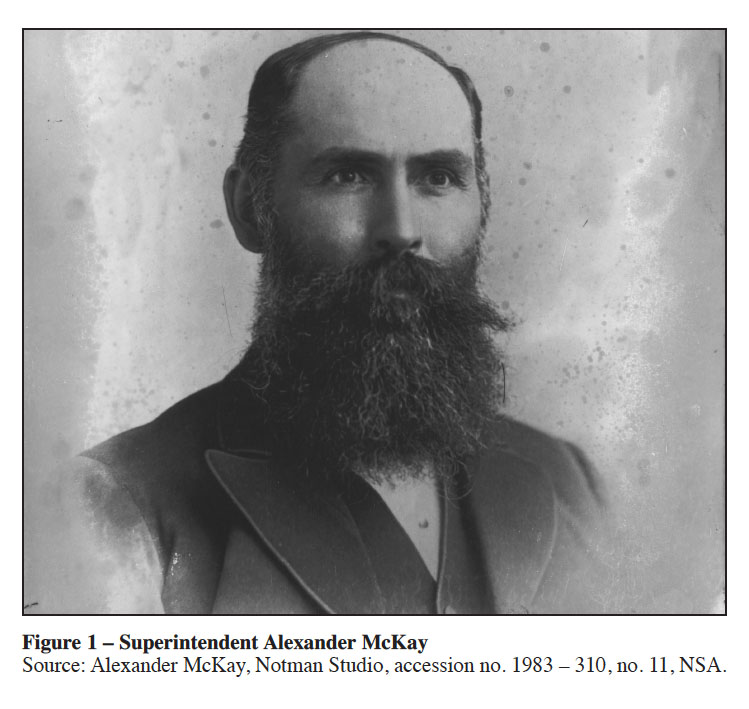 Display large image of Figure 1
Display large image of Figure 119 McKay sought to develop an “industrial sentiment” by promoting industrial training through the study of domestic sciences, agriculture, manual training, and technical courses that would contribute to Nova Scotia’s future. As historian Nancy Sheehan explains: “With industrially trained manpower available, industry might be attracted to Nova Scotia, emigration halted and a return to the prosperity of earlier days accomplished.”41 As one result of McKay’s views, the Normal School and the Agriculture School became affiliated, and teachers were expected to be able to teach lessons related to farm, home, and garden in addition to academic subjects. In this way, McKay changed Nova Scotia’s philosophy of education in an attempt to address industrial needs and keep schools abreast with the broader changes in society and education in Canada. In spite of the province’s economic struggles, McKay was determined to provide educational opportunities to all citizens, which for many years had included the provision of free textbooks for students in need.
Textbook provision and the Nova Scotia School Book Bureau, 1915
20 With the formation of the Nova Scotia Council of Public Instruction in the mid-1860s, the government began providing authorized textbook lists as well as subsidizing up to half of textbook costs for indigent students and one quarter of the cost of the general purchase of books and apparatus.42 V.P. Seary, writing in 1935, suggested that in the late 19th century the Department of Education, having adopted specific textbooks for use in the public schools, saw “change in authorized texts [as] a very undesirable thing; and it is hoped and believed that matters may remain where they are now for years to come without substantial alteration.”43 With regard to the cost of the texts, the 1869 Superintendent’s Report explained that in some 735 school “sections” – or approximately 65 per cent of school districts – books were held as public property and freely used by students. In 305 sections books were sold to students, and in the remaining 96 sections they were “partially retained as public property and partially sold to students.”44 At the end of 1869, however, the government decided to discontinue reducing book prices and, by 1872, government funds designated to help poor students had been reassigned for “the general interests of education.” According to the superintendent’s report, this was done in response to a misappropriation of funds and there were few objections.45
21 Although the cost of schoolbooks emerged as an issue in the 1911 provincial election,46 by 1913 the mid-19th century system of provincial government subsidization of book costs was seen as “a method already tried and given up.” Instead, school districts purchased books at wholesale prices and sold them to parents at cost under the management of the school trustees. Some school districts provided textbooks for free to the “deserving indigent” pupils who could not afford them, while others did not. This system, endorsed by the provincial superintendent of education, was first implemented in the 1870s in some “progressive towns and a city” and expanded into widespread practice until the provision of free textbooks for all elementary school students occurred in 1935.47
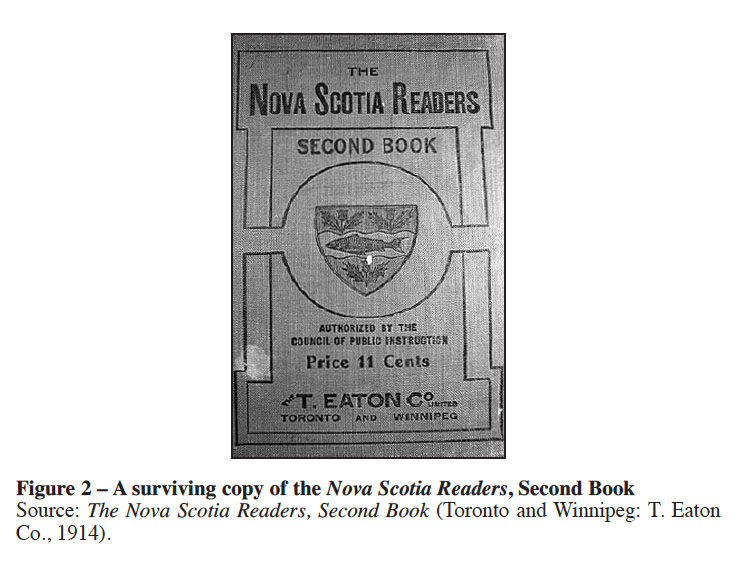 Display large image of Figure 2
Display large image of Figure 222 The Nova Scotia School Book Bureau, which was established in 1915, would play a key role in regulating the cost of books. The school book bureau was a sub-department of the Department of Education, functioning under an appointed manager and, ultimately, the superintendent of education. The bureau set retail prices in an attempt to standardize book prices throughout Nova Scotia and to make them more affordable while, at the same time, allowing a “reasonable profit” for the province’s booksellers. The bureau operated as a central depository, supplying texts to school sections, teachers, booksellers, and the general public. In its first year of operation it supplied only the common school readers and the common school arithmetic text. Beginning in its second year, it was able to supply all of the authorized textbooks. The bureau agreed to re-purchase all unused books in good condition from booksellers at the prices they had paid to the bureau, if and when the books ceased to be prescribed for use in the schools of Nova Scotia. And it adjusted prices upwards to cover costs, ensuring that its activities were self-sustaining.48
23 During the 1913 to 1930 period, the superintendent’s reports note a variety of issues around textbook sales and distribution in the province. First, in accordance with a 1905 agreement with Ontario Premier James Whitney, the Ontario Readers were approved for use in Nova Scotia’s common schools as well as other Ontario texts in Nova Scotia’s high school program beginning in 1914. 49 It took nine years to implement this agreement because Nova Scotia had to complete its current reader contract prior to taking advantage of the Ontario offer. The Ontario Readers, which were published by the T. Eaton Department Store, had tailor-made covers with the title Nova Scotia Readers.50 A set of books that formerly cost $1.89 could be purchased for 49 cents.51
24 While interprovincial cooperation in the production of schoolbooks was “cultivated by the educationalists of Nova Scotia at provincial, interprovincial, and Dominion education conventions,” Superintendent Alexander McKay noted the unequal relationship between the two provinces. Ontario’s government made the texts inexpensive for Nova Scotia by assuming the cost of royalties, editing, typesetting, and the making of the stereotype plates. The superintendent warned that Nova Scotia “could not afford to be recognized as parasitic on the larger province of Ontario, nor to follow her triumphal car of school book production in chains.” He explained that, in future, Nova Scotia must make a proportionate (pro rata) contribution to reducing the cost of the texts, as well as participating in the editorial consultation for new texts.52
25 When the Nova Scotia School Book Bureau was established in 1915, further complications arose. The bureau was granted permission by the Ontario publishers to sell the Nova Scotia Readers at the 20 per cent discount allowed in Toronto, as the bureau would not be making a profit. Initially this seemed sufficient, since the bureau did not pay interest on capital, rent, or taxes and it was expected that it would only need to cover the costs of transportation, packing, management, and distribution of the books. However, it was soon discovered that profits from selling school readers with the regular trade discount would not cover all of the actual expenses, as demonstrated by Table 1.
26 As is evident in this table, receipts and expenditures were very close; but this does not account for the small margin that needed to be allocated for compensating booksellers who returned textbooks that were no longer prescribed or for any other unexpected expenses. Since the legislature had not provided funding to support the bureau’s operations, it had to charge one or two cents more than the price stamped on the covers of the first edition. Some parents were not pleased with this because it appeared to them that the local booksellers were marking up the prices.53 At least partly in response, it was decided that, beginning in June of 1916, the bureau would sell all prescribed school texts at a reduced cost where possible. Booksellers could continue to purchase textbooks to sell to the public, but with the limitation that their discount provided by the bureau be no more than 15 per cent, which would give them a profit of 17.5 per cent on their outlay.54
 Display large image of Table 1Source: NSSE, “Nova Scotia School Book Bureau, Report of the Manager – H.R. Shinner,
B.A.,” Annual Report of the Superintendent of Education for Nova
Scotia for the School Year Ended July 31st, 1915 (Halifax: King’s Printer, 1916),
158.
Display large image of Table 1Source: NSSE, “Nova Scotia School Book Bureau, Report of the Manager – H.R. Shinner,
B.A.,” Annual Report of the Superintendent of Education for Nova
Scotia for the School Year Ended July 31st, 1915 (Halifax: King’s Printer, 1916),
158.
27 Economic conditions stimulated by the First World War brought a number of challenges to the bureau’s efforts to keep textbook prices low. The cost of paper rose, labour shortages occurred, and book distribution was halted at times. In 1917 textbooks manufactured in Great Britain were not received until November, though they had been ordered the previous January. Moreover, as production and material costs rose, the bureau was forced to marginally increase the price of textbooks that had previously been sold below cost.
28 One solution explored by the provinces of Nova Scotia, New Brunswick, and Prince Edward Island according to Superintendent McKay was a move towards increased collaboration in an attempt to secure better terms from publishers and to lower the cost by using uniform textbooks throughout the region:
As a result, the Atlantic Readers, published by Thomas Nelson & Sons, replaced the Nova Scotia Readers in the 1921-1922 school year for grades1-6 in the three Maritime provinces, and they would remain prescribed texts for the next decade.
29 As in Ontario and other parts of Canada, the booksellers of Nova Scotia emerged as opponents of government involvement in textbook sales. A number of merchants objected to the establishment of the school book bureau, questioning the legitimacy of its business, the low price of books, and the government’s part in making such a contract.56 Booksellers objected to the number of people involved in handling books, and some booksellers called for one distributor per town.57 In addition they called for higher-quality books, suggesting that cheap books implied poorer education. Booksellers pointed to parents’ complaints about the cost of books and too-frequent changes in lists of books prescribed.
30 After the Atlantic Readers were introduced in 1921, both the booksellers and the school book bureau manager acknowledged that complaints had appeared in the newspapers about the cost of textbooks.58 The manager of the book bureau, H.R. Shinner, responded defensively in 1922, explaining that textbook costs were irreducible, and resulted from “the wage of the wood cutter, the wood hauler, the pulp worker, the paper maker, the paper distributor, the binding cloth makers, the binders, the paste makers, the printers, etc., as well as the prices paid for the materials used.”59 The only profit gained by the bureau was that needed to cover the cost of distribution. But according to a 1922 article by the editor of Bookseller & Stationer, there was “considerable dissatisfaction over the manner in which textbooks [were] distributed” and booksellers hope[d] action would be taken.60 The article provides examples of dissatisfaction expressed by booksellers in several provinces, and includes a comparative price list from a bookseller in Nova Scotia for 1920 and 1921 for grades 6 and 10 textbooks. The Grade 6 chart indicates a general price increase of 96 per cent and the Grade 10 chart one of over 61 per cent:
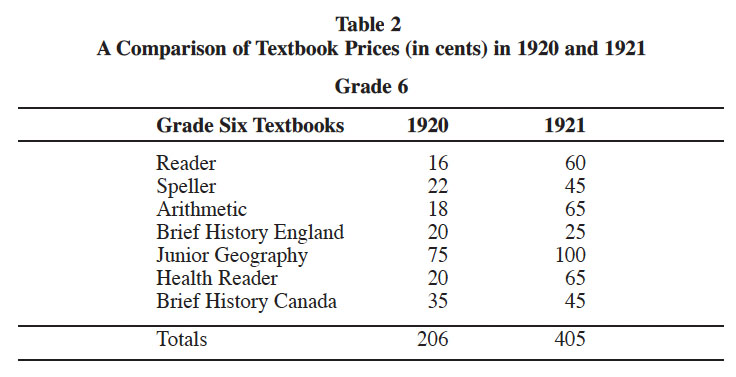 Display large image of Table 2Source: “School Book Question in Canada,” Bookseller and
Stationer XXXVIII, no. 8 (August 1922): 72.
Display large image of Table 2Source: “School Book Question in Canada,” Bookseller and
Stationer XXXVIII, no. 8 (August 1922): 72.
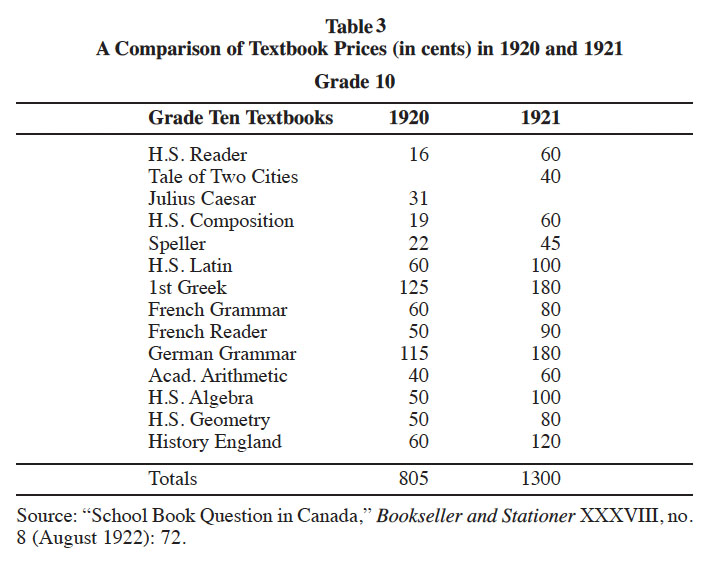 Display large image of Table 3Source: “School Book Question in Canada,” Bookseller and
Stationer XXXVIII, no. 8 (August 1922): 72.
Display large image of Table 3Source: “School Book Question in Canada,” Bookseller and
Stationer XXXVIII, no. 8 (August 1922): 72.
31 The bureau maintained that the books were acquired from publishers at the lowest competitive figures, and pointed out that school sections had the freedom to supply books at reduced cost or even for free if they chose to raise taxes accordingly. It was estimated that textbooks had an average life of three years, and although students sometimes needed several new books in one year this was typically not the case. This was why the book bureau felt a fair basis on which to consider cost was the cost of all books per pupil per year. The cost per year, per pupil, was calculated at 78.3 cents or about 1/5 of a cent a day in the common school grades, and $1.15 per pupil per year, or about 1/3 of a cent a day, for high school students. Manager Shinner remained firm that the cost of texts was therefore very low per capita.61
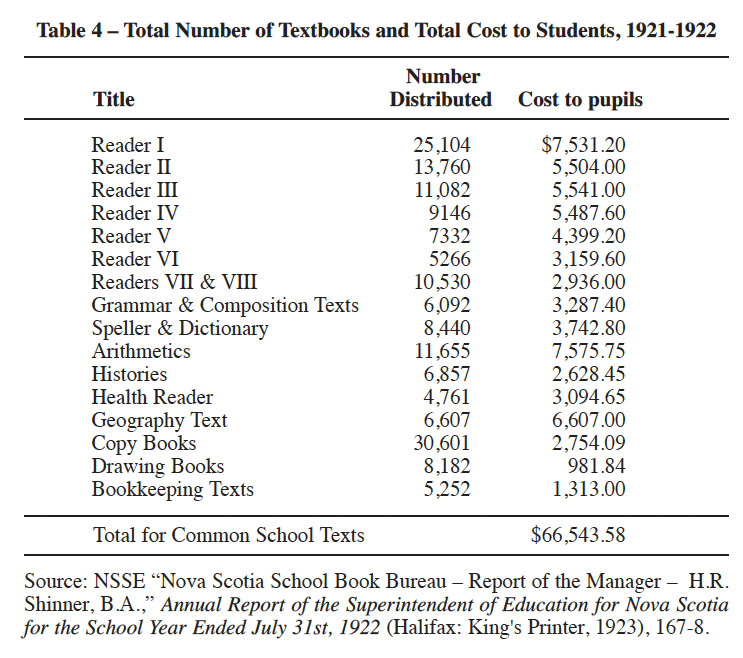 Display large image of Table 4Source: NSSE “Nova Scotia School Book Bureau – Report of the Manager – H.R. Shinner,
B.A.,” Annual Report of the Superintendent of Education for Nova
Scotia for the School Year Ended July 31st, 1922 (Halifax: King's Printer, 1923),
167-8.
Display large image of Table 4Source: NSSE “Nova Scotia School Book Bureau – Report of the Manager – H.R. Shinner,
B.A.,” Annual Report of the Superintendent of Education for Nova
Scotia for the School Year Ended July 31st, 1922 (Halifax: King's Printer, 1923),
167-8.
32 Government involvement in the provision of school textbooks continued to be a point of contention between the booksellers and provincial departments of education in the early 1920s. In an open letter to the Ontario minister of education, one bookseller, C.L. Nelles of Guelph, Ontario, objected to the ministry’s arrangements with publishers – made without booksellers’ input. Nelles informed the minister that booksellers would meet and decide on retail prices that suited themselves, regardless of the prices published in the books. He pointed to the uniformity in textbooks being considered in the Maritimes, suggesting it would bring about “greater efficiency and the advancement of national ideas.”62 C.G. McLeod, a bookseller in Sydney, Nova Scotia, commented “There is not enough in the line at fifteen percent.” He added: “While the bookseller cannot do business on this he must carry school books to hold other business. There is no objection to pay in advance but the percentage is not considered sufficient.”63 It was not until schoolbooks became exempt from federal sales tax on 11 April 1924 that booksellers across Canada would find relief.64
33 Free Textbooks in Nova Scotia 77
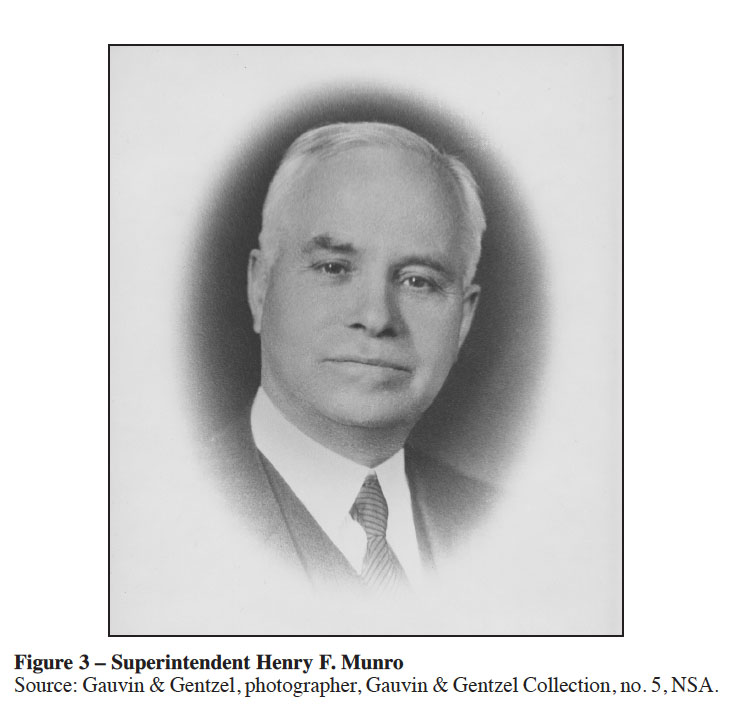 Display large image of Figure 3
Display large image of Figure 334 The Atlantic Readers were not the only instance of regionalism in textbook development and authorization. In 1926 the departments of education of New Brunswick, Prince Edward Island, and Nova Scotia met to consider a policy of shared textbooks. As a result of this meeting, a committee of teachers was formed by the Nova Scotia Education Office to compile a list of suitable textbooks to present at a series of conferences held in Halifax and Fredericton in the winter of 1927. Discussion about joint textbooks took place on the basis that only key books would be considered and no change be made unless necessary. Unanimous agreement resulted in a move toward uniformity, which Superintendent Henry F. Munro upheld as having “sentimental value” as well as “academic and practical advantages” and would contribute to both a sense of community in the Maritime Provinces and national unity.65
35 In July 1924, though manufacturing prices showed little change, the bureau began to reduce the cost of common school textbooks to students by absorbing approximately half of the cost. This totalled to nearly $35,000 in savings for parents. This raised hopes for a textbook system that was entirely free to students and their parents. As the Halifax school inspector explained: “While free books may not at the beginning be provided for all pupils, a plan may be formed which will greatly benefit many who find a heavy task in providing school books for their children.”66
Superintendent Henry F. Munro and opposition to free textbooks, 1926-1935
36 Under the leadership of the “scholarly humanitarian” Superintendent Henry F. Munro (1926-1949), increased efforts were made in the 1930s to bring about a limited improvement in Nova Scotia’s education system.67 Munro was interested in clarifying the purposes of education as well as sorting out the practicalities. However, Munro dashed any optimism about the possibility of free textbooks. In his 1927-1928 annual report he questioned the logic in the suggestion that local authorities already covering the cost of education for all students should also take responsibility for the tools of learning. He observed that the provision of free textbooks was already possible under the Education Act (1918) and was being carried out by one or two school boards in the province, and suggested “it makes for more responsibility in expenditure of this kind, if the local authorities, not the central government, provide the text books.”68 Munro developed his latter point by referencing Oklahoma, where free textbooks were introduced in 1923 and it was believed that the provision of textbooks by a local rather than distant taxing authority would ensure the books would be better cared for. He noted, however, that free textbooks in Oklahoma were repealed by popular vote just four years later.
 Display large image of Figure 4
Display large image of Figure 4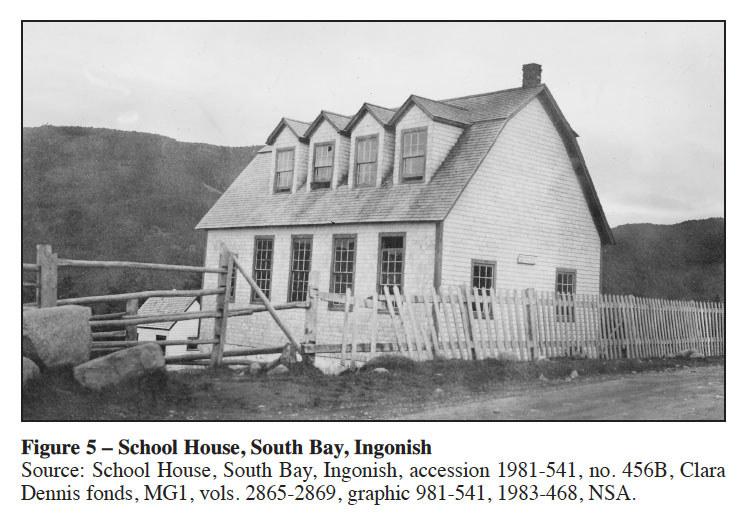 Display large image of Figure 5
Display large image of Figure 537 Munro questioned why the provincial government and local school boards should need to take up the burden of free textbooks when, according to him, most parents were able to afford them without any significant hardship: “Why not regard expenditure on text books (at present lowered to the public by fifty per cent) as a contribution towards education from those who get value received?” He also pointed to British Columbia’s Survey of the School System (1925), which recommended the discontinuation of the practice of issuing free textbooks. At more than $100,000 per year, the commissioners argued the money could be better spent on schools. The superintendent concluded that if the Department of Education were to provide free textbooks, the cost would be approximately $80,000, and that “there are many more fruitful uses for such an expenditure.” The “fruitful uses” he proposed were stocking school libraries, increasing teachers’ salaries, expanding the normal colleges, increasing school inspections, and working to improve rural schools; see Figure 4 and Figure 5 for typical urban and rural schools. He concluded this section of his report with the comment: “Until revenues for education are more buoyant and demands for expansion less urgent, it would seem inexpedient to divert a further sum for a purpose which would have little perceptible effect on educational progress.”69
38 In his 1928-1929 report Munro again soundly rejected the idea of free textbooks, arguing that textbooks were only a means to an end and that he would prefer to see money directed towards libraries. He pointed out that the actual cost of subsidizing half the cost of students’ textbooks saved each student only about 80 cents, and added that “most of the recipients of this bounty are able to pay for it. Those who are not could very well be provided with free textbooks by the local school authorities. In any specific case the burden would not be heavy.” He emphasized this point by minimizing the benefits: “So far from really promoting the cause of education, this money might well be buried in the Sahara.” And he concluded this part of his report by stating: “The Department of Education, therefore, would strongly urge that the present practice be changed and that there be adopted the policy, not of free text books but of free books. After all, text books are only a means to an end, the ability, namely, to use and enjoy books themselves.”70 There is no indication that Munro considered free textbooks to be a frivolous expenditure, but he did not view a free textbook policy as a top priority at a time when funds were limited. As his colleague Guy Henson noted, “Dr. Munro took office at a low point in Nova Scotia’s history.”71
39 Indeed, many aspects of education were in need of funding in Nova Scotia relative to other provinces in Canada as illustrated, for example, by Table 5:
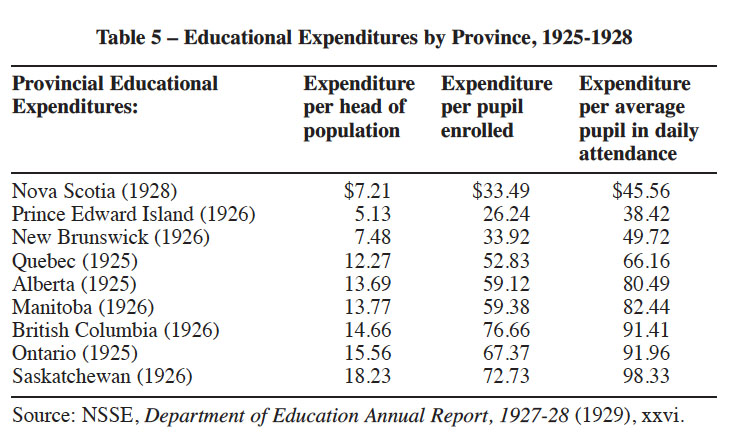 Display large image of Table 5Source: NSSE, Department of Education Annual Report, 1927-28 (1929), xxvi.
Display large image of Table 5Source: NSSE, Department of Education Annual Report, 1927-28 (1929), xxvi.
40 Nova Scotia was the second lowest of the provinces in terms of educational expenditures and there was a significant gap between the three Maritime provinces and the others.
41 Teachers in this period were determined to see more government funding go to the profession for improvement of salaries and Superintendent Munro was in support.72 Teachers’ salaries formed a significant portion of overall educational expenditures. In his 1927-1928 Superintendent’s Report, Munro laid out average salaries of teacher by province:
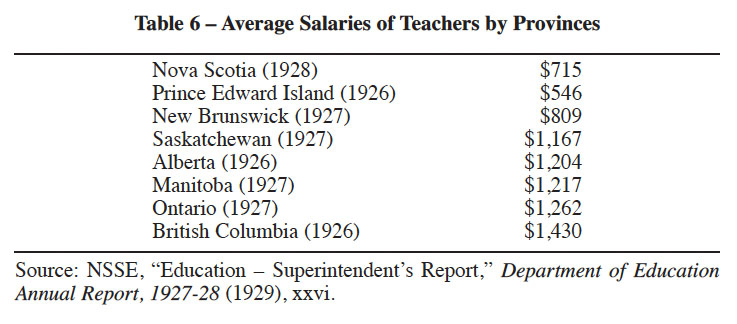 Display large image of Table 6Source: NSSE, “Education – Superintendent’s Report,” Department of Education Annual Report, 1927-28 (1929), xxvi.
Display large image of Table 6Source: NSSE, “Education – Superintendent’s Report,” Department of Education Annual Report, 1927-28 (1929), xxvi.
42 Again, Nova Scotia was the second lowest in Canada.73
43 Reporting in 1931 on the work of a committee under the Council of Public Instruction (CPI), Munro stated: “Much of its preliminary labour has centered on the philosophy underlying a course of study. Substantial agreement has been reached on the fundamental aims of public education and the conditions essential to realize them.”74 School rates and taxation were not standardized across the province and this was deemed undemocratic. Attention was directed towards redistributing financial support for schools to provide for the interests of rural schools, which depended on government grants due to a low tax base.75 One proposal to address these concerns was for the government to provide equalization funds and to establish minimum wages for teachers. However, funds were lacking for these initiatives (see tables 5 and 6). In 1931, Munro remarked: “Reforms will have to wait until the present economic blizzard blows over and more genial winds prevail.” Despite the lack of funds, Munro also noted in his report “it is encouraging to know that our free school system, rooted in the soil for almost seventy years, not only is weathering the worldwide depression but continues to give evidence of a sustained and healthy growth.” 76
44 In August of 1933, the CPI reminded its readership that the book bureau was authorized to provide school boards with textbooks that were to be distributed free of charge to students in need.77 School boards were required to send a requisition to the school book bureau, listing the names of necessitous pupils who were to receive the free textbooks. The requisitions were to be certified by the inspector for the board where the necessitous students attended school. These books were inscribed with the name of the school board and were to be returned at the end of the school year for future use. Each recipient was sternly warned: “No such necessitous pupil shall receive free from the Book Bureau more than one copy of a text-book prescribed for a given grade.”78
45 Superintendent Munro worked hard for the betterment of education in Nova Scotia, but, given the economic constraints, he did not see a free textbook policy as a feasible response to the troubles inherent in the education system of the province. The other factor was the absence of a chorus of voices advocating for a free textbook system. For example, unlike in British Columbia, there was no organization that spoke on behalf of the school districts; the Nova Scotia School Boards Association was not founded until 1954. The attention of the Nova Scotia Labour Party was (rightly) focused on jobs, wages, and working conditions. The Nova Scotia Teachers Union was formed in 1895, but, like the Nova Scotia Labour Party, its concerns were primarily related to salary and working conditions. In addition, although there were “public-spirited citizens,” they were not speaking out in the manner that occurred in British Columbia.79 A 1922 study of education in the Maritime Provinces, published by the Carnegie Foundation for the Advancement of Teaching, is relevant in this regard. The report refers to “the widespread apathy toward public education in Nova Scotia. It chills one like an east wind.”80 Three years after the report, there was no mention of education in the platforms of either the provincial Conservative or Liberal parties.81
Angus Macdonald and a free textbook policy, 1930-1944
46 Lawyer and war veteran Angus Macdonald was elected leader of the Liberal Party of Nova Scotia at its convention in October of 1930. The party was looking for a youthful leader with an unblemished record and no direct association with former Liberal provincial governments. The balloting was dramatic because he was an 11th-hour nomination who went on, after initially refusing to run, to win a resounding victory. The party pledged itself to a 15-point platform at the convention, and point #14 was “to provide free school books for pupils of the public schools up to and including Grade 8.”82
47 Once Macdonald was elected premier in August of 1933, he discovered that the introduction of free textbooks would be more complicated and far more expensive than anticipated. It is not surprising that there was a failure to anticipate the costs involved, given the following note in the superintendent’s report of 1933-1934: “For some reason it has never been the practice to include, in the amount of total government expenditure on education, the loss sustained by the Book Bureau by way of reductions in the prices of text books.”83 Of Munro and Macdonald and their relationship, Department of Education bureaucrat Guy Henson had this to say:
 Display large image of Figure 6
Display large image of Figure 648 In August 1934, Macdonald met with the Council of Public Instruction and a group of educational officials to discuss school textbooks.85 The curriculum committee that had been appointed in 1930 by the CPI to consider this issue had, in March, 1933, issued a report calling for changes in textbooks and designating certain publishing firms as responsible for textbook orders. With new books issued, the decision was made to let the previous supply of textbooks run out. This unforeseen circumstance would make the introduction of free textbooks particularly expensive. It was estimated that the cost of new textbooks would be $242,000. Before the policy regarding free textbooks was announced, the book bureau had planned to sell the books to parents for a total of $125,000 while the government was willing to pay the remaining $117,000 to “save parents” as they had done since 1924.86 As mentioned above, in the case of parents unable to pay the government agreed to provide books, on the condition that parents who could pay would continue to do as they had done in the past. The free books were supplied to the school trustees and returned by the children to the school board or trustees at the end of the school year, as was the annual practice. Under this arrangement, the CPI’s extensive changes to the textbook supply were considered affordable. With the government absorbing all of the cost of textbooks, however, the CPI’s substitutions became a cause for concern.
49 By the time Macdonald’s Liberal government took office in September of 1933, it was too late to make changes to the arrangements made by the curriculum committee as new books had already been ordered. Publishers had stopped publishing the previous books, and begun building up supplies of newly prescribed texts. Unable to avoid the unexpected expense, Macdonald later explained, “there was no other course open to us but to accept the arrangement, even though it involved a heavy and unlooked for expenditure by the Province and by parents of children.” With regard to free textbooks, the premier explained in August 1934:
50 Table 7, which includes information about per capita income in every province leading up to and during the Great Depression, provides insight into Macdonald’s concerns. Despite the premier’s recognition that a free textbook policy would incur an expense beyond the province’s means, within two years of taking office free textbooks were introduced. As of July of 1935, textbooks were made available without cost for all students in grades 1 to 8.88
51 As was customary practice in other provinces, textbooks were the property of the local school board and collected and redistributed at the end and beginning of each year. Principals and teachers were responsible for keeping the textbooks and were instructed to maintain borrowing records from year to year. Students who damaged or lost a textbook were required to purchase a replacement. Bookstores were no longer permitted to sell textbooks to students. Instead, the textbooks were distributed from publishers to teachers via bookstores or through the school trustees. Parents or students interested in purchasing their own textbook for grades 1 to 8 were required to do so through the school book bureau or the classroom teacher. Students in grades 9 through 12 continued to purchase textbooks, either through the bookstores, the book bureau, or their teachers. High school students who were unable to afford textbooks were no longer provided with them at no cost. By November of 1935, the Nova Scotia School Book Bureau had distributed 452,779 new textbooks free of charge to local school boards at a cost of approximately $210,416.52.89
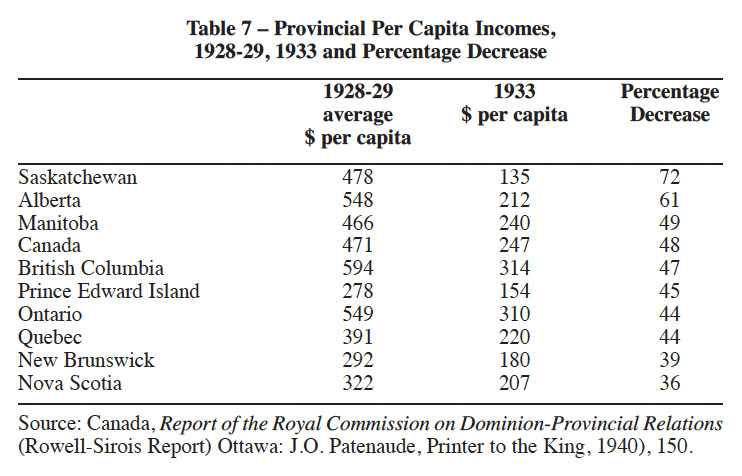 Display large image of Table 7Source: Canada, Report of the Royal Commission on
Dominion-Provincial Relations (Rowell-Sirois Report) Ottawa: J.O. Patenaude,
Printer to the King, 1940), 150.
Display large image of Table 7Source: Canada, Report of the Royal Commission on
Dominion-Provincial Relations (Rowell-Sirois Report) Ottawa: J.O. Patenaude,
Printer to the King, 1940), 150.
52 Textbook distribution costs were anticipated to fall within two years, and rise again the fourth year as the average textbook lasted three years. A long-term analysis of the book bureau and superintendent’s reports, however, reveals that the cost of providing free textbooks continued to climb over time. The 1943-1944 book bureau report notes that the operating expense of the bureau had risen the highest since free textbooks were introduced in 1934, and subsequent reports demonstrate that it continued to rise. Although the bureau was sometimes able to stabilize operating costs from year to year, the unit cost of books continued to rise over the course of the next century with spikes in years when new textbooks were introduced.90
53 Regardless of administrative costs, the free textbook policy made a positive difference to lives lived in homes and schools. It lightened the burden of parents, who no longer had to carefully preserve older brothers’ and sisters’ tattered books for younger siblings; parents also did not have to “beg, borrow, or steal” them from relatives and neighbours or dip into family funds to purchase them. In classrooms, teachers were no longer required to adapt lessons in order to accommodate those students who did not possess the preferred text or who owned an older edition with outdated information.
54 In acting to equalize educational opportunity, Angus Macdonald was consistent with both Liberal policy and his own lifelong values. He came from a family of 14 children – 11 of whom survived to adulthood – with 6 attending St. Francis Xavier University, and 5 continuing their education after acquiring undergraduate degrees. Macdonald paid his own way through university, taking time away to teach school in order to pay the bills. He completed a law degree and eventually earned a doctorate at Harvard. Clearly, he prized education. The state of the economy in the 1935-1936 fiscal year may also have been a factor. Instead of the predicted $360,000 deficit, there was a surplus of more than $150,000 that year.91
55 According to Nova Scotia’s Report of the Royal Commission on Provincial Development and Rehabilitation, between 1938 and 1943 the province increased its spending on education by more than 25 per cent, from $4,400,000 to $5,564,000. Yet there remained significant dissatisfaction.92 And there was little agreement about what form change might take. In spite of the rising costs, the context of provincial economic struggle, and debates about students’ carelessness in the use of textbooks, though, the free textbook policy was never revoked. The book bureau, one century old in 2015, remains in operation.93
Conclusion
56 Set in the context of economic struggle, powerful opposition, and the lack of equally powerful voices calling for change, a policy of free textbook provision for all students was a low priority and relatively delayed in Nova Scotia. While people in some other provinces were debating this policy in the 1890s and early 1900s, Nova Scotia’s educational leaders were focused on developing industrial education in response to the province’s struggling economy. Once the book bureau was established in 1915, leaders were for the most part content with first providing books for students in financial need and then with subsidizing the cost of textbooks for all students. As was the case in other provinces, booksellers proved to be strong opponents of the book bureau – criticizing the government’s involvement in sales and the prices they set for schoolbooks as well as the idea of providing students in grades 1 through 8 with textbooks at no cost.
57 Superintendent of Education Henry F. Munro, who assumed the position in 1926, was not enthusiastic about free textbooks. With teachers paid among the lowest salaries in Canada and resources sparse, the superintendent’s office had more pressing concerns to which to attend. Nova Scotia also lacked the powerful lobby groups, such as the British Columbia School Trustees’ Association and the Vancouver and Victoria Trades and Labor Council, who were so vocal, and ultimately so successful, in achieving their ends in British Columbia, which instituted the most comprehensive free textbook policy in the nation at the time. Though unsuccessfully addressed by politicians in 1911, the cost of textbooks was once more approached when free textbooks for all students was included as a Liberal campaign promise in 1930. Once he was premier, Liberal leader Angus MacDonald, with a minimum of communication with the Council for Public Instruction, successfully implemented the policy. The policy was a fait accompli and the education bureaucrats had no choice but to carry it out.
58 This investigation of the free textbook policy in Nova Scotia in the comparative context of other provinces, and British Columbia in particular, makes some things clear. First, individuals in powerful positions can make a significant difference. Superintendent Alexander McKay was determined to provide educational opportunities for all children, and his determination resulted in the provision of free textbooks to students in need. Henry F. Munro, the next superintendent, had other priorities, resulting in a delay in the escalation of provision. The history of Canadian education is replete with examples of the influence of particular individuals on educational policy. The 1930s was a particularly vibrant decade, with enormous changes being wrought by individuals such as Hubert Newland and Donalda Dickie in Alberta, George Weir in British Columbia, and Thornton Mustard in Ontario. A second point is that political will can trump other considerations. Premier Angus Macdonald was determined to honour his commitment, made in better economic times, and he did so despite dire economic circumstances. Third, education does not exist in isolation. We have seen that it is influenced by politics. It is also affected by economics, although the economic context can be mitigated to a degree. Nova Scotia’s economic situation delayed the introduction of free textbooks, but the province still introduced the policy 16 years before the much wealthier province of Ontario. Finally, departments of education respond to external pressure – a point that was starkly evident in the case of British Columbia. The absence of powerful lobby groups in Nova Scotia made it easy for Superintendent Munro to follow his own inclinations for some time with little interference. Ultimately, in the case of Nova Scotia and free textbooks, the concept of equality of educational opportunity triumphed over economic conditions, practical priorities, and the absence of a clamour of voices raised in support.